6.2: The USSR and the Russian Federation (3 Day)
- Page ID
- 1891
- Define the main tenets of a socialist economy.
- Describe some of the conditions of life in the Soviet Union.
- Briefly explain why the Union of Soviet Socialist Republics (USSR) collapsed.
- Describe the post-Soviet economic and political situation.
TEKS Regional Unit 6: Russia, the Caucasus and Central Asia; Chapter 6.2 The USSR and the Russian Federation
WG.1A Analyze the effects of physical and human geographic patterns and processes on the past and describe their impact on the present, including significant physical features and environmental conditions that influenced migration patterns and shaped the distribution of culture groups today.
WG.7B Explain how political, economic, social, and environmental push and pull factors and physical geography affect the routes and flows of human migration.
WG.13A Interpret maps to explain the division of land, including man-made and natural borders, into separate political units such as cities, states, or countries.
WG.14A Analyze current events to infer the physical and human processes that lead to the formation of boundaries and other political divisions.
WG.14B Compare how democracy, dictatorship, monarchy, republic, theocracy, and totalitarian systems operate in specific countries.
WG.14C Analyze the human and physical factors that influence the power to control territory and resources, create conflict/war, and impact international political relations of sovereign nations such as China, the United States, Japan, and Russia and organized nation groups such as the United Nations (UN) and the European Union (EU).
WG.15A Identify and give examples of different points of view that influence the development of public policies and decision-making processes on local, state, national, and international levels
WG.16A Describe distinctive cultural patterns and landscapes associated with different places in Texas, the United States, and other regions of the world and how these patterns influenced the processes of innovation and diffusion.
WG.17A Describe and Compare patterns of culture such as language, religion, land use, education, and customs that make specific regions of the world distinctive.
WG,18A Analyze cultural changes in specific regions caused by migration, war, trade, innovations, and diffusion.
WG.19C Examine the environmental, economic, and social impacts of advances in technology on agriculture and natural resources.
WG.21C Create and Interpret different types of maps to answer geographic questions, infer relationships, and analyze change.
WG.22A Design and Draw appropriate graphics such as maps, diagrams, tables, and graphs to communicate geographic features, distributions, and relationships.
WG.22B Generate summaries, generalizations, and thesis statements supported by evidence.
WG.22C Use geographic terminology correctly.
The USSR and the Russian Federation
As we learned in "Introducing the Realm", the Russian Empire was built by the czars over the course of a few hundred years. However, the economic and political systems of the Russian Empire were not sustainable in the modern era. The vast majority of the population was poor, and most were landless peasant farmers. In a place with short growing seasons, farming was not an easy path to riches.
Political decisions were made by a small elite group. At the dawn of the 20th century, 100 years after the Industrial Revolution swept through Great Britain and Western Europe, Russia remained an agricultural country and had not yet begun large-scale industrialization. Outside of the aristocracy, few supported the status quo in Russia, and there was widespread desire for a new political system and government.
However, no one could agree on what a new government would look like. In the aftermath of World War I, a civil war erupted in Russia. During these chaotic times, the last czar, Nicholas II, was forced from office. He and his family were executed. The most powerful group battling for control of Russia was a Communist group called the Bolsheviks, which translates to the “larger group.” Other groups, including the “smaller group,” the Mensheviks, lost the civil war. The Bolshevik leader was Vladimir Lenin. In 1917, he and his supporters began the process of changing Russia into a Communist state.
The capital city was moved back to Moscow from St. Petersburg where it had been since the time of Czar Peter the Great in the 18th century. St. Petersburg’s name was changed to Petrograd and then Leningrad in honor of Vladimir Lenin. The entire territory of the Russian Empire was turned into the Union of Soviet Socialist Republics (USSR). The Russian people traded a monarchy for a Marxist totalitarian state.
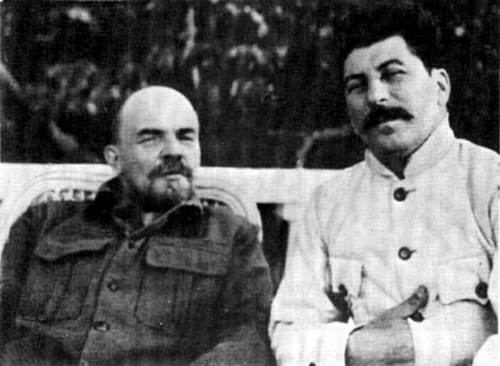 Vladimir Lenin and Josef Stalin, 1922.
Vladimir Lenin and Josef Stalin, 1922.The Soviet Union lasted from 1922 to 1991. Joseph Stalin, the Soviet dictator who took over after Lenin was incapacitated in 1922 and died in 1924. Stalin was a ruthless leader who killed or exiled anyone who got in his way. Stalin is famous for initiating economic plans that helped move Russia from a poor, agrarian state to a large, industrial superpower. He pushed for rapid industrialization, the eradication of family farms in lieu of large communal farms, the end of personal ownership of land or businesses, and the dramatic weakening of organized religion. All these changes came at a great price.
During his reign of terror, an estimated 30 million people lost their lives. The forced collectivization of agriculture brought about a devastating famine in 1932–33, in which between six to eight million people starved to death. Stalin led periodic purges of his perceived political enemies. The largest of these is known as the Great Purge. At that time (1936–38), about one million people were executed. The full extent of Stalin’s purges may never be fully known. Stalin’s rule ended in 1953 when he reportedly died of natural causes.
Marxist-Leninist Central Planning
The Soviet Union espoused the philosophies of Karl Marx, a 19th-century German theorist. Marx wrote that all political and economic life can be understood as a struggle between the various classes in society. People who adhere to Marx’s philosophy are called Marxists. The Soviet version of Marxism is called Marxism-Leninism. In Marxist thought, capitalism is an oppressive economic system in which the working class (the proletariat) is oppressed by the bourgeoisie (the wealthy middle class).
Marxists believe that the proletariat should revolt, rise up against the bourgeoisie, take the property away from the rich, and give it to the government to control it for the benefit of the common people. Ultimately, a pure Communist system would result, with no social or economic classes, no private property, no rich people, and no poor people.
As a socialist state, the Soviet Union did not include open markets. The Soviet Union was a command economy, in which economic decisions were made by the state and not left to the market to decide. During the Soviet era, for example, industrial production was planned by the central government. The government would decide what would be produced, where it would be produced, the quantity produced, the number of workers who would produce it, where the raw materials would come from, and how the final product would be distributed. By mobilizing the entire country to work toward common goals, the USSR was able to achieve rapid industrialization.
Another main economic feature of the Soviet Union was collectivized agriculture. The Soviet leaders did not want individual, capitalist farmers to become rich and threaten their economic system. Nor did they want thousands of small, inefficient farms when the country was perpetually unable to feed itself. Instead, they decided to streamline agricultural production into large farm factories.
All the farmland in each area was consolidated into a government-owned collective operation. Some collective farms were run by the state, while others were run by private cooperatives. During the transition period to collective farming, individual farmers were forced to give up their land, animals, farm equipment, and farm buildings and donate them to the collective farm in their area.
The state also demanded a high percentage of the crops produced. At times, the government collected the entire harvest, not even allowing seed crops to be held for the following season. This brought about widespread famine in 1932–33. Collectivized agriculture remained the norm in the Soviet Union until the country’s dissolution in 1991 and even afterward in some areas.
The Cold War
From the end of World War II in 1945 until the collapse of the USSR in 1991, the Soviet Union and the United States competed in the global community for the control of labor, resources, and world power. Each side attracted allies, and most countries were on the side of either the United States or the Soviet Union. This era, known as the Cold War, did not involve direct military armed conflict between the United States and the Soviet Union, but it transformed the world into a political chessboard, with each side wanting to block the other side from gaining ground.
Whenever the Soviets would enter into an alliance with a certain country, the United States was right there to try to counter the move. Wars, armed conflicts, sabotage, spying, and covert activities were the methods of the Cold War. Both sides stockpiled as much deadly weaponry as possible, including nuclear warheads and missiles. They also competed in the race to put people in outer space.
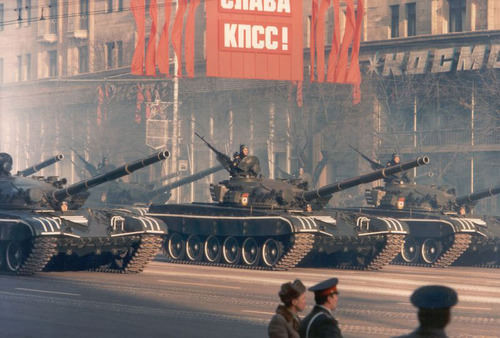 October revolution celebration 1983, Moscow, during the Cold War.
October revolution celebration 1983, Moscow, during the Cold War.The Cold War led to wars fought in Vietnam, Korea, Grenada, Afghanistan, Angola, and the Middle East, with the Soviet Union funding one side and the United States the other. Covert wars or guerrilla wars with secret agents and political assassinations were fought in Cuba, Nicaragua, Chile, Guatemala, Mozambique, Laos, Cambodia, and a host of other third-world countries.
The Cold War divided the world into two main camps, each with a high number of nuclear weapons. Eastern Europe was sectioned off by the Iron Curtain, and the Berlin Wall divided the city of Berlin, Germany. These physical barriers divided the communist countries of Eastern Europe with the capitalist countries of Western Europe. Germany was divided into East and West.
Various Soviet dictators came to power and died in office before the end of the Cold War. The last Soviet leader was Mikhail Gorbachev, who assumed power in 1985. The U.S. president at the time was Ronald Reagan. During the 1980s the United States was outspending the Soviets militarily, and its economy was growing at a much faster rate than that of the USSR. At the same time, the Soviets were engaged in a costly war in Afghanistan, and their economy was faltering and in danger of collapse.
Gorbachev realized that reforms had to be implemented to modernize the Soviet system. Political life needed to be more open so that people would feel ownership of the country, and the economy needed to be restructured. Gorbachev implemented perestroika (restructuring of the economy with market-like reforms) and glasnost (openness and transparency of all government activities). The restructuring exposed fundamental problems in the economy, and by 1990 the Soviet economy was in worse shape than ever before.
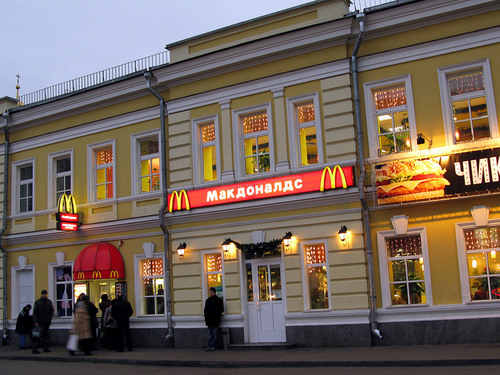 The first McDonald’s restaurant in the former Soviet Union was in Moscow, Russia.
The first McDonald’s restaurant in the former Soviet Union was in Moscow, Russia.The end came in 1991. The Soviet Union collapsed when 14 of the Soviet republics broke away and declared their independence. At this point, the Soviet state was too weak to prevent it. All the republics, including Russia itself (now called the Russian Federation), became independent countries. The only territories that did not achieve independence were the smaller republics and autonomous regions that existed within the Russian Federation’s boundaries.
The Iron Curtain was taken down seemingly overnight, and people were free to travel to and from the former Communist countries. The old Russian flag flew over the Kremlin—the seat of the Russian government—for the first time since Czar Nicholas II had been in power 73 years earlier. The Communist era of the Soviet Union and the Cold War were over.
 Kremlin is a Russian word for a walled city. Inside Moscow’s Kremlin is the famous Red Square.
Kremlin is a Russian word for a walled city. Inside Moscow’s Kremlin is the famous Red Square.The post-Soviet transition was filled with political, economic, and social turmoil. Boris Yeltsin, the first president of the new Russian Federation, ushered in a series of economic reforms that privatized state-owned enterprises. Russian leaders tried to reverse socialism rapidly through what they called “shock therapy,” which they knew would be painful but hoped would be brief. These reforms created a new class of capitalist entrepreneurs.
Wealth, once controlled by the political elite, was now being shifted to the business elite, a pattern found in most capitalist countries. Many ordinary workers faced unemployment for the first time as the new owners of various companies trimmed unnecessary staff. Private ownership forced housing costs to skyrocket, and while families were generally allowed to keep the homes they already lived in, purchasing houses or condominiums was too expensive for many people.
The value of the ruble, Russia’s currency, declined rapidly, and older people watched as their life savings evaporated overnight. Western goods were more accessible, and consumer products became more available than they were during the Soviet era. Bread lines and empty store shelves became distant memories as the former Communist state shifted over to a type of capitalist democracy. Yeltsin became less popular as citizens became dissatisfied with corruption and the high social costs of the post-Soviet transition. He resigned in 1999 and was replaced by Vladimir Putin.
- The Region’s Early Heritage
- Vikings created fortified trading towns called gorods
- Genghis Khan’s Mongol Empire invaded (1240 C.E.)
- Feudal states arose around dominant trading centers
- Czarist Russia, 1547–1917
- Czars unified empire by internal colonialism
- Forward capital of St. Petersburg created
- Pioneers pushed eastward to Siberia and North America
- Bolshevik Revolution, 1917–22
- Czar Nicholas II and his family executed
- Russian Civil War fought
- Vladimir Lenin created Communist imperial state
- The capital moved to Moscow; republics broke away
- The Soviet Union (USSR), 1922–91
- Czarist Empire became the Soviet Union
- Central planning, collectivization, and the Cold War began
- Republics kept together by military force
- External interaction of glasnost initiated (the 1980s)
- Economic restructuring and reforms of perestroika introduced (the 1980s)
- The Russian Republic, 1991–Present
- Independent republics lost with internal unrest
- Economics privatized
- Democracy introduced (the 1990s)
- Central state strengthened (21st century)
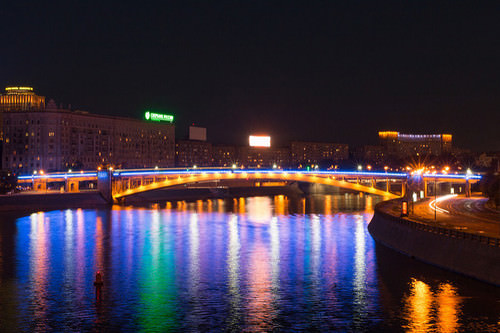 Behind the Borodinsky Bridge on the right are the government buildings of the Russian Federation.
Behind the Borodinsky Bridge on the right are the government buildings of the Russian Federation.Twenty-First-Century Russia
A Russian style of capitalism replaced the social, political, and economic system of the Communist era with a growing market economy. The export of Russia’s vast quantities of natural resources, such as oil, natural gas, and timber, to Europe and the rest of the world helped the country rebound from the economic collapse of the 1990s. Russia has benefited from the recent increase in energy prices, and oil, natural gas, metals, and timber account for more than 80 percent of exports and 30 percent of government revenues.
However, Russia still needs to modernize its dilapidated manufacturing base if it is to economically compete against the European Union, North America, or eastern Asia. During Vladimir Putin’s presidency, Russia witnessed substantial economic growth that inspired foreign investors to pump money into the Russian economy and catapulted Moscow into an investment haven and one of the richest cities in the world. Russia has become a major player in the global economy, although much of its population still suffer from poverty and social problems.
Russia’s population grew steadily during the Soviet era, except during periods of famine or warfare. The country underwent a rural-to-urban shift as farm workers moved to cities to labor in factories. However, when the USSR collapsed, Russia’s population fell sharply from a peak of 149 million in 1991 to about 143 million in 2005. The trend of low birth rates actually began during the Soviet period.
The population decline occurred because birth rates always decline during periods of economic and social crisis as people delay or decide against having children. In addition, the country experienced high death rates because of alcoholism, heart disease, and the collapse of the social safety net. Any time death rates surpass birth rates, a country’s population will decline unless the difference is offset by immigration.
Russia’s birth rate was also impacted by high rates of abortion. In 1992, for example, there were 221 abortions in Russia for every 100 live births.[1] Although Russia’s population has seemingly bottomed out, the only reason it is not continuing to decline is immigration from the former Soviet republics. Russia still has a negative rate of natural increase.
To put Russia’s demographic profile in context, its fertility rate was only about 1.5 in 2010, meaning that the average woman would have 1.5 children in her lifetime. This is below the 2.1 children each woman would need to have for the population to remain stable. The fertility rate in Russia is similar to that of countries in Europe (1.5) but lower than that of the United States (2.1). [2] Life expectancy for Russian men is variously reported as 60 years up to 63 years, while women can expect to live 73 to 75 years. In Western Europe, life expectancies are about 80 years.
About 80 percent of Russia’s population is ethnically Russian. The next largest group is Tatar (3.8 percent), a group that traditionally has spoken the Tatar language and practiced Islam. More than 150 ethnic groups are represented in Russia, including indigenous people of the Arctic who herd reindeer for a living. Each of the nationalities of the former Soviet republics has a presence in Russia. Because of its relatively strong economy, Russia (especially Moscow) is an immigration magnet for residents of those countries. Most of these groups have their own language and cultural traditions.
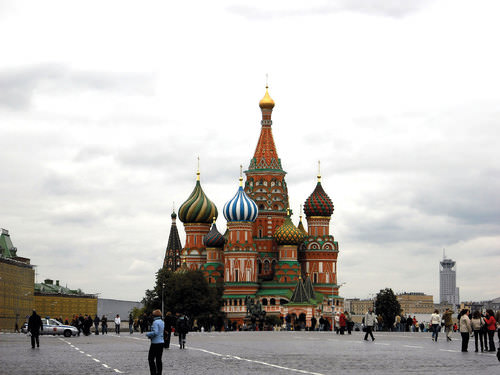 The Cathedral of Intercession of the Virgin on the Moat, also known as the Cathedral of St. Basil the Blessed, on the Red Square, Moscow.
The Cathedral of Intercession of the Virgin on the Moat, also known as the Cathedral of St. Basil the Blessed, on the Red Square, Moscow.The Russian Orthodox Church is the dominant religious denomination in Russia. For generations, it was the country’s official religion, and Russian people were automatically considered to be Orthodox, no matter what their personal beliefs. During the Soviet era, the government did much to weaken the church, including killing thousands of priests, monks, and nuns and closing most churches.
The much smaller church that survived was largely controlled by the state. Because of state-sanctioned atheism during the Soviet era, only 15 to 20 percent of Russia’s population today actively practices Orthodoxy, although a much greater number claim to be Russian Orthodox Christians. Another 15 percent of the country’s population practices Islam, especially in places such as the Caucasus region and the southern Ural Mountains. About two percent practice other forms of Christianity, such as Catholicism and Protestantism. [3] Even though Orthodoxy is practiced by a minority of Russia’s population, the church has increased its influence since 1991 and often acts as an official church. A small percentage of the population are Buddhists, and various ethnic groups in Siberia and the Far East practice tribal religions and pagan rites.
The Russian Language
Like English, Russian is an Indo-European language. Russian is on the Slavic branch of the language tree, along with languages such as Polish, Ukrainian, and Serbo-Croatian. A relatively new language, it developed from a language called Old East Slavic that was spoken around 1100 C.E. Medieval Russian developed in the 13th century, and modern literary Russian is usually traced back to the early 19th century. Russian uses the Cyrillic alphabet, which was developed from Greek. The Russian language is the official language of the Russian republic. With over 100 languages used in the country, 27 of them are officially recognized in various regions within the republic.
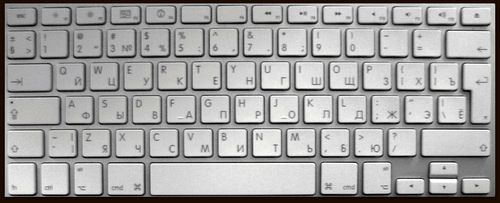 Apple Keyboard for a Russian Computer.
Apple Keyboard for a Russian Computer.- The Communist state was created in 1917 as the result of a civil war, which evolved into the creation of the Soviet Union in 1922. During this era, the Russian people traded a monarchy for a Marxist totalitarian state.
- One of the primary goals of the new USSR was rapid industrialization, and this goal was achieved through central planning and the collectivization of agriculture. Inefficiencies in the system persisted throughout the Soviet era.
- The Soviet Union’s Communist system was maintained at great cost: millions were killed by purges and in government-produced famines.
- A weakened USSR tried to reform in the 1980s through Mikhail Gorbachev’s policies of perestroika and glasnost but instead collapsed in 1991.
- Early post-Soviet years were ones of democratization, rapid privatization, and the unraveling of the social safety net.
- The shift to capitalism restructured the Russian economy.
- The Russian economy strengthened after 2000, and Russian president Vladimir Putin strengthened the power of the central state.
- Russia has a low fertility rate and a negative rate of natural increase. High rates of abortions and alcoholism have been contributing factors.
- The Russian Orthodox Church is the dominant religious denomination in Russia.
Vocabulary Terms
| Caucasus | A region that crosses the Caucasus Mountains and stretches between the Black and Caspian Seas. |
| Chernobyl | City in the Ukraine where nuclear plant meltdown took place in 1986. |
| Communism | A social and economic system in which most property is owned by the government and shared by the governed |
| consumer goods | Things that are grown or made by production used by people |
| Czar (Tsar) | Title given to the emperor of Russia prior to the Russian Revolution |
| Glasnost | Reform policy which allowed for more openness by the government instituted by Mikhail Gorbachev. |
| Joseph Stalin | Leader of the Soviet Union during World War II |
| Karl Marx | German philosopher, famous for his ideas about the struggle between the rich and poor. He wrote the Communist Manifesto and is considered the father of communism |
| Mikhail Gorbachev | Leader of the Soviet Union in the mid 1980s. He began a dramatic restructuring of Soviet political and economic policies |
| perestroika | The reform of government and economy in the former Soviet Union |
| permafrost | Permanently frozen soil |
| Vladimir Lenin | Leader of the communist revolution and first leader of the Soviet Union |
Applying Knowledge
Discussion and Study Questions
- By what process did the Russian Empire become the Soviet Union?
- Who were the first two leaders of the USSR. What were some of their accomplishments? What were some of the human costs?
- What were some of the main features of Karl Marx’s philosophy?
- What were two main economic policies of the Soviet Union?
- Who was fighting the Cold War? Where were major conflicts fought during this war?
- How did the Cold War end? What leaders were in power in the United States and the Soviet Union when it ended?
- What two policies did the last Soviet leader implement to assist in reforming the USSR?
- What happened to the many external republics after 1991?
- How did the economic system change for Russia after 1991?
- What are some reasons for Russia’s population decline?
Real-World Geography Exercise
Using Google Maps, locate the places below. Calculate the distance and how long it would take to fly in an airplane from your hometown to each city. Be prepared to share your answers.
- Moscow
- St. Petersburg
Mapping Exercise
Hot Spots in a Cold War: Students will use mapping software to analyze and explain the reasons for the development of the Cold War conflicts between the USSR and the USA after World War II.
Videos for Geography Enrichment
Helpful Websites for the Study of Geography
Canadian Encyclopedia is an encyclopedia funded by the Canadian government covering all branches of knowledge. Their scholarly collection includes interactive materials.
CIA World Factbook provides information on the people, history, government, economy, energy, geography, communications, transportation, military, and transnational issues for the world's entities.
Congress.gov is a U.S. government website where you can find federal legislation, past and present, as well as information about the U.S. legal system.
Drug Enforcement Administration (DEA) is a government agency website that provides current news, resources, topics of interest, information about drugs, careers in the DEA, and a tip hotline.
Library of Congress is the largest library in the world and provides manuscripts, files, information, pictures, and videos.
NASA Earth Observatory (NEO) is a U.S. government agency website that allows users to search for and retrieve satellite images of Earth.
National Archives is a U.S. government website that provides historical documents, photos, records, publications, and educator resources.
National Oceanic and Atmospheric Association (NOAA) is a U.S. government agency website that provides weather-related information and ocean research.
National Map is a website by the United States Geological Survey and other federal, state, and local agencies that delivers topographic information for the United States.
NationMaster is a massive central data source and a handy way to graphically compare nations.
Real-Time World Air Quality Index is a website that measures most locations in the world for air pollution in real time.
StateMaster is a unique statistical database, which allows you to research and compare a multitude of different data on U.S. states.
United Nations (UN) is an international organization founded in 1945 and made up of 193 member states. The UN maintains international peace and security, protects human rights, delivers humanitarian aid, promotes sustainable development, and upholds international law.
United States Census Bureau is a U.S. government agency that provides a population clock, data, surveys, statistics, a library with information and infographics, news about the economy, and much more.
United States Geological Survey (USGS) is a U.S. government agency website that provides scientific information about the natural hazards that threaten lives, the natural resources we rely on, the health of our ecosystems and environment, and the impacts of climate and land-use change.
Whitehouse.gov is a U.S. government website that provides the latest presidential news, information about the budget, policy, defense, and many more topics.
World Health Organization (WHO) is under the United Nations and provides leadership on matters critical to health; shapes the research agenda on health; and monitors the health situation and assessing health trends around the world. Their website provides information on the state of health around the world, outbreaks, current health news, and more.
World Trade Organization (WTO) is an intergovernmental organization that regulates international trade. The website provides information on the history of the multilateral trading system, featured videos, news and events, trade topics, and more.
Footnotes
[1] “Historical Abortion Statistics, Russia,” Johnston`s Archive, http://www.johnstonsarchive.net/policy/abortion/ab-russia.html.
[2] “The World Factbook,” Central Intelligence Agency, https://www.cia.gov/library/publications/the-world-factbook/geos/xx.html.
[3] “The World Factbook,” Central Intelligence Agency, https://www.cia.gov/library/publications/the-world-factbook/geos/xx.html.
Students will use mapping software to analyze and explain the reasons for the development of the Cold War conflicts between the USSR and the USA.

